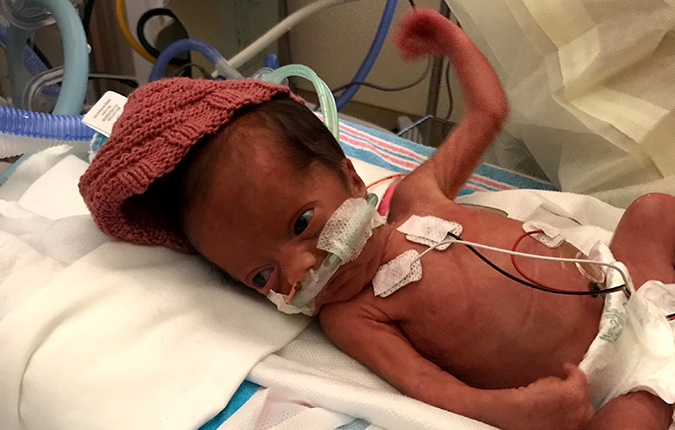Condition
Pediatric Down Syndrome
Down Syndrome (Trisomy 21)
Key points about Down syndrome
- Down syndrome (trisomy 21) is a genetic disorder. It includes certain birth defects, learning problems and facial features. A child with Down syndrome also may have heart defects and problems with vision and hearing.
- A mother’s age at her child’s birth is the only factor linked to the risk of having a baby with Down syndrome. This risk increases with each year of age, especially after age 35.
- There is no reason to believe a parent can do anything to cause or prevent Down syndrome in their child. Researchers don’t know how to prevent the chromosome errors that cause this disorder.
- Down syndrome can often be diagnosed before birth. After birth, your baby may be diagnosed with a physical exam. Your health care provider may also take a blood sample.
- There is no cure for Down syndrome, but treatment is available to help your child.
- Your child may need physical, occupational and speech therapy to help with his or her development. Many children are helped with early intervention and special education.
What is Down syndrome?
Down syndrome is a genetic disorder. It is also called trisomy 21. It includes certain birth defects, learning problems and facial features. A child with Down syndrome also may have heart defects and problems with vision and hearing. How severe or mild these problems are varies from child to child.
Down syndrome is one of the most common genetic birth defects. It affects about 1 in 800 babies. Adults with Down syndrome may live about 60 years, but this can vary.
What causes Down syndrome?
When a baby is conceived, a normal egg cell and normal sperm cell start with 46 chromosomes. The egg and sperm cells then divide in half. The egg and sperm cells then have 23 chromosomes each. When a sperm with 23 chromosomes fertilizes an egg with 23 chromosomes, the baby will then have a complete set of 46 chromosomes. Half are from the father and half are from the mother.
But sometimes an error occurs when the 46 chromosomes are being divided in half. An egg or sperm cell may keep both copies of chromosome number 21, instead of just 1 copy. If this egg or sperm is fertilized, then the baby will have 3 copies of chromosome number 21. This is called trisomy 21.
Sometimes the extra number 21 chromosome or part of it is attached to another chromosome in the egg or sperm. This may cause translocation Down syndrome. This is the only form of Down syndrome that may be inherited from a parent.
A rare form is called mosaic trisomy 21. This is when an error in cell division happens after the egg is fertilized. People with this syndrome have both normal cells and some cells with an extra chromosome number 21.
Which children are at risk for Down syndrome?
A mother’s age at her child’s birth is the only factor linked to the risk of having a baby with Down syndrome. This risk increases with each year of age, especially after age 35.
What are the symptoms of Down syndrome in a child?
Symptoms can occur a bit differently in each child. They can include:
- Eyes that slant upward
- Small ears that may fold over slightly at the top
- Small mouth that makes the tongue appear large
- Small nose with a flattened bridge
- Short neck
- Small hands with short fingers
- Two instead of three palm creases, including one across the palm and one around the base of the thumb
- Short height
- Loose joints
Most children with Down syndrome will have some but not all of these features.
Down syndrome can also include:
- Heart defects
- Intestinal problems
- Vision problems
- Hearing problems
- Thyroid problems (hyperthyroidism or hypothyroidism)
- Blood conditions, such as leukemia, and risk for infections
- Learning problems
How is Down syndrome diagnosed in a child?
Chromosome problems such as Down syndrome can often be diagnosed before birth. This is done by looking at cells in the amniotic fluid or from the placenta. This can also be done by looking at the amount of the baby’s DNA in the mother's blood. This is a noninvasive prenatal screening. These tests are very accurate.
Fetal ultrasound during pregnancy can also show the possibility of Down syndrome. But ultrasound is not 100% accurate. Problems from Down syndrome may not be seen with ultrasound.
After birth, your baby may be diagnosed with a physical exam. The healthcare provider may also take a blood sample. This is checked in a lab to find the extra chromosome.
How is Down syndrome treated?
There is no cure for Down syndrome. But a child with Down syndrome may need treatment for problems such as:
- Heart defects. About half of babies with Down syndrome have heart defects. Some defects are minor and can be treated with medicines. Others may need surgery. All babies with Down syndrome should be looked at by a pediatric cardiologist. This is a doctor who specializes in children’s heart diseases. Babies with Down syndrome should also have an echocardiogram. This is a test that looks at the structure and function of the heart by using sound waves. This exam and test should be done in the first two months of life. This is so that any heart defects can be treated.
- Intestinal problems. Some babies with Down syndrome are born with intestinal structure problems that need surgery.
- Vision problems. Common problems include crossed eyes, nearsightedness or farsightedness, and cataracts. Most eyesight problems can be made better with eyeglasses, surgery or other treatments. Your child should see an eye doctor (pediatric ophthalmologist) before he or she turns 1 year old.
- Hearing loss. This is caused by fluid in the middle ear, a nerve defect or both. Your child should get regular hearing tests so any problems can be treated early. This will help with language development.
- Other health problems. Children with Down syndrome may have thyroid problems and leukemia. They also tend to have many colds, as well as bronchitis and pneumonia. Your child should get regular medical care and stay up to date on vaccines.
- Learning problems. These vary widely from child to child. They can be mild, moderate, or severe. But most learning problems are mild to moderate. Many children are helped with early intervention and special education.
Some people claim that giving high-dose vitamins to children with Down syndrome will improve their learning and development problems. No studies have proved that this works.
Talk with your child’s healthcare providers about the risks, benefits and possible side effects of all treatments.
What are the possible complications of Down syndrome?
Complications of Down syndrome vary depending on the body organ affected and the severity of the problem. Problems include certain birth defects, learning problems and facial features. A child with Down syndrome also may have heart defects and problems with vision and hearing. How severe the complications are varies from child to child. Treatment will also vary depending on the body organ affected and the severity of the problem. Your child’s healthcare provider will discuss treatment options with you.
What can I do to help prevent Down syndrome in my child?
Researchers don’t know how to prevent the chromosome errors that cause this disorder. There is no reason to believe a parent can do anything to cause or prevent Down syndrome in their child.
For women who have had one child with Down syndrome, the chance of having another baby with Down syndrome depends on several things. Age is one factor. Most babies with Down syndrome are born to women younger than 35. This is because women under 35 have more babies than women over 35.
Your healthcare provider may refer you to a genetic counselor. This expert can explain the results of chromosome tests in detail. He or she can talk about risks for future pregnancies and what tests are available to diagnose chromosome problems before a baby is born.
Some medical organizations advise that all pregnant women of any age be offered screening for Down syndrome. Talk with your health care provider about this prenatal screening test.
How can I help my child live with Down syndrome?
Children with Down syndrome can usually do most things that any young child can do. They can walk, talk, dress themselves and be toilet trained. But they usually do these things at a later age than other children. The exact ages of these development milestones are different for each child. Early intervention programs that begin when a child is a baby can help your child reach his or her potential.
A child with Down syndrome can go to school. Special programs beginning in the preschool years help children with Down syndrome develop skills as fully as possible. Many children are helped with early intervention and special education. They can also enter a regular classroom. Many children will learn to read and write. They can take part in childhood activities, both at school and in their community.
Your child may need physical, occupational and speech therapy to help with his or her development. Talk with your health care provider, other families and national Down syndrome support agencies to learn what to expect with Down syndrome. You can also learn what may be helpful in raising a child with Down syndrome.
Providers Who Treat Down Syndrome
- Helping Maddie to Live Life to the Fullest
Maddie is a lively, creative teen who loves to act. Research at Children's National Hospital helps to ensure that her rare disease doesn"t upstage her big theater plans or her love of life.
Departments that Treat Down Syndrome

Childhood Cancer Genetics
Our cancer genetics experts help answer important questions about your child’s inherited risk for cancer.









